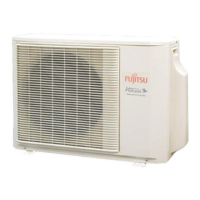Do you have a question about the Fujitsu AOUG12LZAS1 and is the answer not in the manual?
Provides detailed technical specifications for indoor and outdoor units, including capacity, power, and dimensions.
Details the physical dimensions of indoor and outdoor units and specifies required installation clearances for proper operation.
Outlines essential safety measures and precautions for service personnel and handling of the product.
Lists all components of the indoor unit with part numbers and identifies them in an exploded view diagram.
Lists all components of the outdoor unit with part numbers and identifies them in an exploded view diagram.
Details standard accessories supplied with the indoor and outdoor units, such as manuals and mounting hardware.
Describes optional parts like remote controllers and communication kits that enhance functionality or control.
Presents a schematic showing the refrigerant flow path, including key components like the compressor and heat exchangers.
Provides detailed electrical wiring schematics for both the indoor and outdoor units, essential for installation and repair.
Shows the layout and connections of the main Printed Circuit Boards (PCBs) for troubleshooting and component identification.
Explains how to access and clear error codes, and provides tables listing error codes and their meanings.
Offers step-by-step guidance for diagnosing and resolving issues indicated by specific error codes.
Provides diagnostic steps for common operational issues not associated with specific error codes, such as no power or abnormal noise.
Details troubleshooting steps for errors related to wireless LAN communication and adapter functionality.
Details how compressor frequency is regulated based on room temperature, outdoor temperature, and fan speed settings.
Explains the logic for automatic mode switching based on room and outdoor temperatures for optimal comfort.
Covers fan speed settings, airflow control modes (AUTO, QUIET, etc.), and specific fan behavior in different operations.
Describes how to adjust horizontal and vertical louvers for airflow direction and swing operation modes.
Explains the operation and settings for various timer functions, including On/Off, Program, Sleep, and Weekly timers.
Outlines the conditions that trigger defrost operation and the criteria for releasing from defrost mode.
Details various operational controls such as Auto Restart, MANUAL AUTO, Forced Cooling, and MIN. HEAT operations.
Describes the built-in protection mechanisms to prevent damage from high discharge gas temperature, freezing, and pressure variations.
Guides users on how to adjust product functions via the remote controller, including setting numbers and values.
Explains how to interface external devices for input control and output status monitoring using the dedicated PCB.
Provides detailed technical specifications for indoor and outdoor units, including capacity, power, and dimensions.
Details the physical dimensions of indoor and outdoor units and specifies required installation clearances for proper operation.
Outlines essential safety measures and precautions for service personnel and handling of the product.
Lists all components of the indoor unit with part numbers and identifies them in an exploded view diagram.
Lists all components of the outdoor unit with part numbers and identifies them in an exploded view diagram.
Details standard accessories supplied with the indoor and outdoor units, such as manuals and mounting hardware.
Describes optional parts like remote controllers and communication kits that enhance functionality or control.
Presents a schematic showing the refrigerant flow path, including key components like the compressor and heat exchangers.
Provides detailed electrical wiring schematics for both the indoor and outdoor units, essential for installation and repair.
Shows the layout and connections of the main Printed Circuit Boards (PCBs) for troubleshooting and component identification.
Explains how to access and clear error codes, and provides tables listing error codes and their meanings.
Offers step-by-step guidance for diagnosing and resolving issues indicated by specific error codes.
Provides diagnostic steps for common operational issues not associated with specific error codes, such as no power or abnormal noise.
Details troubleshooting steps for errors related to wireless LAN communication and adapter functionality.
Details how compressor frequency is regulated based on room temperature, outdoor temperature, and fan speed settings.
Explains the logic for automatic mode switching based on room and outdoor temperatures for optimal comfort.
Covers fan speed settings, airflow control modes (AUTO, QUIET, etc.), and specific fan behavior in different operations.
Describes how to adjust horizontal and vertical louvers for airflow direction and swing operation modes.
Explains the operation and settings for various timer functions, including On/Off, Program, Sleep, and Weekly timers.
Outlines the conditions that trigger defrost operation and the criteria for releasing from defrost mode.
Details various operational controls such as Auto Restart, MANUAL AUTO, Forced Cooling, and MIN. HEAT operations.
Describes the built-in protection mechanisms to prevent damage from high discharge gas temperature, freezing, and pressure variations.
Guides users on how to adjust product functions via the remote controller, including setting numbers and values.
Explains how to interface external devices for input control and output status monitoring using the dedicated PCB.
| Type | Split System |
|---|---|
| Cooling Capacity | 3.5 kW |
| Heating Capacity | 4.0 kW |
| SCOP | 4.0 |
| Energy Efficiency Class (Cooling) | A++ |
| Energy Efficiency Class (Heating) | A+ |
| Refrigerant | R32 |
| Power Supply | 220-240 V, 50 Hz |
| Noise Level (Indoor) | 22 dB(A) |
| Noise Level (Outdoor) | 49 dB(A) |











